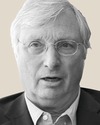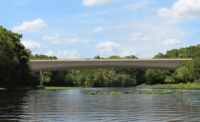
Hundreds of sustainability experts converged on Long Beach, Calif., to discuss engineering resilient infrastructure in a world challenged by sea-level rise and climate change. Co-sponsored by the American Society of Civil Engineers and China's Tianjin University, the conference was billed as the first to focus on key issues in international sustainable infrastructure.
"Environmental and social impacts are playing a bigger role in projects. We want these impacts to be considered, because many of today's problems are huge and require big solutions to be implemented quickly to avoid disasters," says William A. Wallace, a key organizer of the Nov. 4-7 conference and president of Wallace Futures Group, a Steamboat Spring, Colo., sustainability consulting firm. "We don't want our grandchildren's grandchildren to have half as much livable earth to work with."
 |
| WALLACE |
"The environmental challenges for China are huge and many," said John Crittenden, director of the Brook Byers Institute for Sustainable Systems. Many major cities in the country are poised to grow into megacities, each with a population in excess of 20 million, he added. According to Crittenden, how China grows in the next few decades will greatly impact the world. Global engineering disciplines will influence sustainable infrastructure.
"Continuing to build highways isn't going to cut it," said Douglas Sereno, program manager of the Port of Long Beach and a member of ASCE's committee on sustainability. He said industrial expansion is affecting the planet so severely that it is changing the levels of disasters for which engineers must design. Sereno said conditions designed for in the past are not the same as what will be faced in the future. "The traditional role of the engineer has changed," he noted.
 |
| HIRSCH |
Presenters also focused on the engineering community itself, emphasizing that engineers must make better use of their technical expertise to influence the planning and building of projects that develop sustainable solutions. "I became an engineer because I wanted to contribute to increasing the quality of life for everyone," says Sereno. "Quality of life is directly proportional to the quality of infrastructure." Improving the quality of life prompted Laurel Sukup, section chief of business development at the Wisconsin Dept. of Natural Resources, to attend the event on personal vacation time.
"The passion is deep in my soul," said Reg Andres, president of the Canadian Society of Civil Engineers. "For 15 years, I've had this itch in my back to make a change." Andres said that the new Envision sustainability rating tool, for which ENR cited Wallace last year for his foundational work (ENR 1/27/14 p. 48), is a major step in the right direction.
"We're running out of time, and our communities are demanding leadership," said D. Michael Mucha, chief engineer and director of the Madison, Wis., Metropolitan Sewerage District and chairman of ASCE's sustainability committee. He said the world "is looking for someone to step into the void and provide solutions to make life better."
Wallace said the next ASCE global infrastructure conference will be in Beijing in 2016, co-sponsored by the Chinese Academy of Engineers and Tsinghua University.



Post a comment to this article
Report Abusive Comment